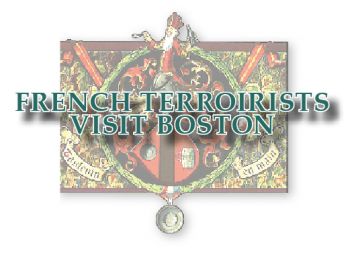French Terroirists Visit Boston
The Grand Conseil 2O11, this year’s edition of the annual international meeting of the Confrérie des Chevaliers du Tastevin, the Burgundy education and chowder society, was held in Boston in May. Among the participants who came from France, Canada, and all over the US were three celebrated Burgundian vignerons, terroirists all: François Bitouzet of Domaine Bitouzet-Prieur in Meursault and Volnay, Philippe Senard of Domaine Comte Senard in Aloxe-Corton, and Laurent Ponsot of Domaine Ponsot in Morey-Saint-Denis. One of the events of the Conseil, a tasting luncheon at the Mandarin Oriental Hotel, seamlessly blended education, sensuous pleasures, and conviviality, when, with the help of the current and immediate past leaders of the Massachusetts branch of the Confrérie, who acted as interlocutors, the three winegrower-ambassadors – in person at the luncheon and by film from their vinous domains – expounded and expanded on the terroirs and wines of their respective communes.
Terroir is a French word. Among its dictionary definitions are “ground”, “earth”, and “location”. It is viewed variably in the wine world, depending on who and, especially, where you ask. In the New World (I’m thinking mainly of California), many deny its existence. They seem to think the vines can grow just as well in sawdust, and that climate rules. Moderates of various nationalities accept the concept on terroir, and include within its purview such essential elements as climate, topography, and drainage, in addition to the nature of the soil and subsoil. Europeans, the French in particular, are strong believers in terroir. Burgundians, in the heartland of terroir, view it as what’s under their feet and as the prime determinant of wine’s character. Of course, no one denies that man’s adventures in viticulture, especially in limiting yields, and in manipulations of winemaking and aging play some part.)
Just exactly how a particular terroir leads to a particular type of wine remains mysterious, but, other factors being equal (and barring overenthusiastic idiosyncrasies in the winery), one can discern distinct characteristics in the wine of a given terroir, especially in Burgundy. Matt Kramer writes, “The Earth speaks in Burgundy as it does nowhere else.” He refers to a “somewhereness” of good wine and, to explain the French mindset, to their delight in differences and acceptance of ambiguity, their disinclination to expect one growing site to replicate the qualities of another.
The divisions of Burgundy into its patchwork of vineyards, largely set in motion by medieval monks and nuns, gained empirical validation over the centuries. Engrained in the region, the system is not to everyone’s liking. As Jean-Robert Pitte relates, “The Bordelais . . . above all are irritated by the division of miniscule appellations into a multitude of parcels belonging to many owners: to the Bordelais mind, such a practice is incomprehensible and unjustifiable.” Sometime vast differences between wines of the same Burgundian vineyard and vintage, but of different producers, do support the Bordelais complaint, though wines of quality do express their birthplaces. One vigneron I know in Beaune, himself respecting terroir, told me that “buying Burgundy is not a spectator sport, but a contact sport.”
The region’s common thread is limestone, of several varieties, the compressed residuum of creatures of the ancient sea that had covered Burgundy in geologic times and of precipitates of calcium compounds from the seawater. The limestone is mixed with varying proportions of clay, sand, gravel, and stones. Meursault’s limestone is relatively young, less evolved than some. On the Hill of Corton, as in other communes, one can see that what the French call terroir is layered: light on top, darker as one digs deeper, in part because of iron deposits. These layers can be viewed revealingly bottom to top from 35 feet below the surface in Ponsot’s cellar in Morey-Saint-Denis, dug in 2OO1. At the base is the hard “mother rock”, above which are compressed oyster and other shells, first yellowish in tone, iron-stained in places, topped by still lighter limestone, and then a thin layer of topsoil.
Ponsot demonstrated the vine roots in his deep cellar, explaining that from their second year they penetrate the rock about three feet per year by means of an acidic rock-dissolving secretion, to reach the heart of the terroir after seven or eight years. The rootlets retreat back up during each dormant season, then return the next year to penetrate further and to absorb the essences of each individual terroir, so to inform the vine, the grape, the wine.
Of Meursault’s extensive vineyards, 98 percent grow chardonnay. The wines, less finely focused than, say, those of Puligny-Montrachet, are fresh, more quickly accessible and fatter, good partners for fish or for cheese. Aloxe-Corton grows more grand cru than any other commune, almost uniquely both white and red at that exalted level. A few domains still add a bit of supermature white grapes (pinot gris, here called beurot) to the red. The reds tend to be the most tannic of the Côte d’Or, thus requiring longer aging. Morey-Saint-Denis, anonymously sold as Gevrey-Chambertin or Chambolle-Musigny until well into the 2Oth century, may have the features of either. The wines, mostly red, often have rich, deep, dark fruit on a firm structure.
The differentiating process, vineyard parcel to vineyard parcel, has been likened to the vines playing the keyboard of variegated Burgundian terroirs.

